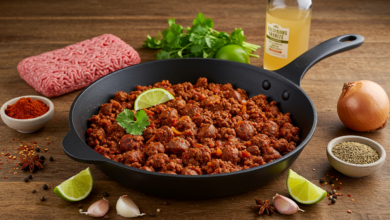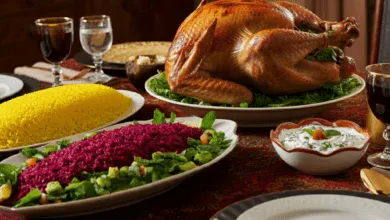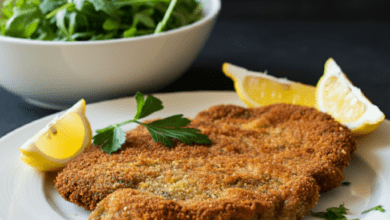Easy Crab Brulee Recipe

This Easy Crab Brûlée Recipe is a delightful fusion of flavors, blending the natural sweetness of crab with the creamy richness of a savory crème brûlée. It’s perfect for special occasions or as an impressive appetizer. This version simplifies the process without compromising on taste, making it the Best Crab Brûlée Recipe you’ll try.
Table of Contents

Ingredients
For the Crab Custard:
- 200g (7 oz) fresh crabmeat (preferably lump crabmeat)
- 250ml (1 cup) heavy cream
- 100ml (½ cup) whole milk
- 3 large egg yolks
- 2 tbsp crème fraîche or sour cream
- 1 small shallot, finely minced
- 1 clove garlic, finely minced
- 1 tbsp unsalted butter
- 1 tsp Dijon mustard
- 1 tsp lemon zest (finely grated)
- 1 tbsp freshly squeezed lemon juice
- Salt and freshly ground black pepper, to taste
- A pinch of cayenne pepper or paprika (optional, for subtle heat)
- 4 tbsp granulated sugar (for caramelized topping)
For Garnish:
- Fresh herbs (like parsley or chives) for garnish
- Lemon wedges for serving
Instructions
1. Prepare the Crab Custard Base:
- Cook the Aromatics:
In a small skillet, melt the unsalted butter over medium heat. Add the minced shallot and garlic, sautéing until they become soft and translucent (about 2-3 minutes). Set aside to cool slightly. - Mix the Wet Ingredients:
In a mixing bowl, whisk together the heavy cream, milk, and crème fraîche. Slowly incorporate the egg yolks one by one, ensuring that the mixture remains smooth and creamy. - Add Flavor:
Stir in the Dijon mustard, lemon zest, lemon juice, a pinch of salt, pepper, and cayenne pepper (if using). Once the sautéed garlic and shallot have cooled, fold them into the custard mixture.
2. Incorporate the Crabmeat:
- Carefully fold the fresh crabmeat into the custard base. Be gentle to avoid breaking up the lumps of crab, as you want the texture to be delicate and light.
3. Baking the Crab Custard:
- Preheat the Oven:
Preheat your oven to 150°C (300°F). Prepare a bain-marie (water bath) by filling a large baking dish with hot water. The water level should reach halfway up the sides of the ramekins. - Divide the Mixture:
Pour the crab custard mixture into individual ramekins, filling them about three-quarters of the way. Place the ramekins into the prepared water bath. - Bake the Custard:
Transfer the baking dish to the oven and bake for 40-50 minutes, or until the custards are set but still slightly jiggly in the center. The texture should be smooth and creamy, similar to a savory crème brûlée. - Cool the Custard:
Remove the ramekins from the oven and let them cool to room temperature. Once cooled, cover and refrigerate for at least 2 hours, or overnight, to allow the flavors to meld together.
4. Caramelizing the Top:
- Add Sugar:
Before serving, sprinkle about 1 tablespoon of granulated sugar evenly over the surface of each custard. - Torch the Sugar:
Using a kitchen torch, caramelize the sugar until it turns golden brown and crisp. If you don’t have a kitchen torch, you can place the ramekins under a preheated broiler for 1-2 minutes, watching carefully to avoid burning.
5. Garnish and Serve:
- Garnish the Easy Crab Brûlée with freshly chopped herbs, and serve with lemon wedges on the side. The combination of the savory crab custard with the crunchy, caramelized sugar top makes this the Best Crab Brûlée Recipe for impressing your guests.
Tips for the Perfect Crab Brûlée
- Choose Quality Crab:
Fresh lump crabmeat is ideal for this recipe, as it provides a delicate texture and flavor. If fresh crabmeat isn’t available, you can use high-quality canned crab, but make sure to drain it well and remove any excess moisture. - Season Lightly:
Crab has a naturally sweet and subtle flavor, so avoid overpowering it with too much seasoning. The goal is to enhance the crab’s sweetness, not to mask it. - Use a Water Bath:
A water bath (bain-marie) ensures that the custard bakes gently and evenly, preventing it from curdling or cracking. - Caramelize Carefully:
When torching the sugar, keep the flame moving to avoid burning any one spot. If using a broiler, watch closely, as the sugar can burn quickly.
Frequently Asked Questions (FAQ)
1. Can I use a different type of seafood?
Yes! While crab is the star of this dish, you can experiment with other shellfish such as lobster, shrimp, or even scallops. Just be mindful that the texture and sweetness of each seafood type may alter the final result slightly.
2. Is this dish served hot or cold?
Crab Brûlée is typically served cold or at room temperature. The custard needs time to chill and set, and the caramelized sugar adds a nice contrast when freshly torched right before serving. However, some people prefer it slightly warm after broiling the sugar topping. Both methods work depending on your personal preference.
3. Can I make Crab Brûlée ahead of time?
Absolutely! You can make the custard portion up to two days in advance and store it in the fridge. Wait until just before serving to caramelize the sugar topping to ensure it stays crisp.
4. What is the texture of Crab Brûlée like?
The texture of the custard should be silky, smooth, and slightly firm, similar to a traditional sweet crème brûlée but with the savory twist of crab. The contrast between the creamy custard and the crunchy caramelized sugar creates a delightful mouthfeel.
5. What should I serve with Crab Brûlée?
Crab Brûlée makes an excellent appetizer or small plate on its own. However, you can also pair it with a light salad, some toasted baguette slices, or a glass of crisp white wine like Sauvignon Blanc or Chardonnay.
6. What’s the origin of Crab Brûlée?
While Crab Brûlée isn’t a traditional dish with a long history, it’s a modern fusion of classic French crème brûlée and savory crab-based dishes. This kind of fusion cuisine has gained popularity in recent decades as chefs look for creative ways to reimagine traditional flavors.
7. Can I use imitation crab for this recipe?
While you can use imitation crab if you’re in a pinch, the flavor and texture won’t be the same. Imitation crab is often made from processed fish and lacks the sweetness and delicacy of real crab. For the best results, stick to fresh or high-quality canned crabmeat.
8. Do I need a kitchen torch to caramelize the sugar?
A kitchen torch gives you the best control when caramelizing the sugar, but if you don’t have one, you can use your oven’s broiler. Just keep a close eye on the sugar to prevent it from burning, as the broiler can be quite powerful.
9. Can I freeze Crab Brûlée?
Freezing isn’t recommended for this dish. The custard may separate and lose its creamy texture upon thawing. If you want to make it ahead, it’s best to store it in the fridge and serve it within a couple of days.
10. What are some variations I can try?
There are several fun variations you can explore with this dish:
- Lobster Brûlée: Swap out the crab for lobster meat for an even more luxurious treat.
- Herbed Crab Brûlée: Add fresh tarragon or dill to the custard mixture for a fragrant twist.
- Spicy Crab Brûlée: For a kick, add a pinch of cayenne or a dash of hot sauce to the custard base before baking.
11. Can I make a large batch in one dish rather than individual ramekins?
Yes, you can make this recipe in a larger dish, but the cooking time will be longer. Keep an eye on the custard, checking for that slight jiggle in the center to know when it’s ready. The water bath is still essential to ensure even cooking.
12. What type of sugar should I use for the caramelized top?
Granulated sugar works best for the caramelized topping, as it melts and browns evenly. You could also experiment with superfine sugar, which may give a slightly smoother finish, but avoid powdered sugar, which doesn’t caramelize properly.
Final Thoughts
Crab Brûlée is an indulgent, unexpected take on a traditional dessert that’s sure to wow your guests. The rich, savory flavors of the crab combined with the creamy custard base and the sweet, caramelized sugar topping create a dish that’s as elegant as it is



